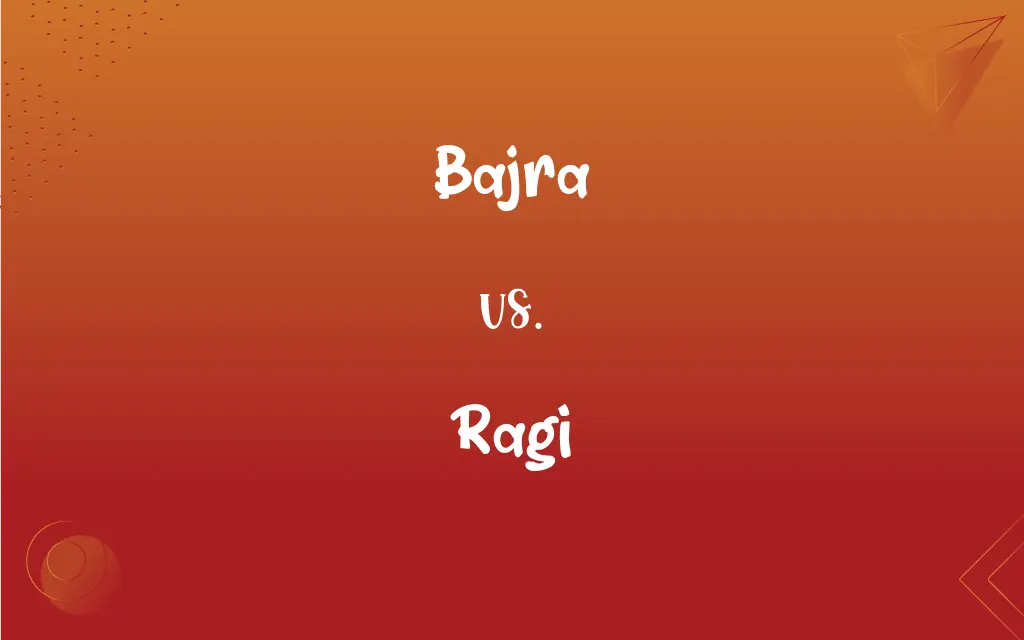Bajra vs. Ragi: What's the Difference?
Edited by Aimie Carlson || By Janet White || Published on February 27, 2024
Bajra (pearl millet) and ragi (finger millet) are both nutritious grains; bajra is larger, beige-colored, while ragi is smaller, reddish-brown, and slightly sweeter.

Key Differences
Bajra, or pearl millet, is a robust, drought-resistant grain predominantly cultivated in Africa and the Indian subcontinent. It's characterized by its round, beige-colored grains and is known for its high energy content. Ragi, also known as finger millet, is smaller in size, with a distinctive reddish-brown color and a slightly sweet flavor. It's widely grown in Africa and Asia and is celebrated for its high calcium content.
Nutritionally, bajra is rich in carbohydrates and protein, making it an excellent energy source. It also contains essential amino acids, making it beneficial for a vegetarian diet. Ragi, on the other hand, is exceptionally high in calcium, iron, and dietary fiber, making it a great choice for bone health and digestion. Both grains are gluten-free, making them suitable for those with gluten intolerance.
In culinary uses, bajra is often ground into flour and used in flatbreads, porridges, and snacks. Its nutty flavor makes it a popular choice in traditional dishes. Ragi's versatility in the kitchen is notable; it's used in porridges, unleavened bread, and even in sweet dishes due to its natural sweetness. It's also a popular ingredient in baby food because of its nutritional profile.
Bajra thrives in arid conditions and is often grown in areas where other cereals might fail, making it a crucial crop for food security in many parts of the world. Ragi, while also drought-resistant, prefers slightly cooler highland climates. Both grains are important in sustainable agriculture due to their minimal water and fertilizer requirements.
Culturally, both bajra and ragi hold significant places in various cuisines. Bajra is a staple in many parts of India, often used during fasting periods. Ragi, with its rich nutrient profile, is considered a 'superfood' in parts of India and Africa, often introduced as one of the first solid foods to infants.
ADVERTISEMENT
Comparison Chart
Grain Size and Color
Larger, beige-colored grains
Smaller, reddish-brown grains
Nutritional Content
High in carbohydrates and protein
High in calcium, iron, and dietary fiber
Culinary Uses
Used in flatbreads, porridges, and snacks
Used in porridges, breads, and sweet dishes
Growing Conditions
Thrives in arid conditions
Prefers cooler highland climates
Cultural Significance
Staple in Indian cuisine, used in fasting
Considered a superfood, used in baby food
ADVERTISEMENT
Bajra and Ragi Definitions
Bajra
Bajra is often used in fasting foods in Indian culture due to its nutritional value.
During the fasting period, many people consume dishes made from bajra.
Ragi
Ragi flour is versatile, used in porridges, breads, and sweet dishes.
Ragi dosa is a healthier alternative to the traditional rice dosa.
Bajra
Bajra is a type of pearl millet, known for its robust, drought-resistant qualities.
In the arid region, farmers rely heavily on bajra as their main crop.
Ragi
Ragi grows well in cooler highland climates and is drought-resistant.
Our family farm in the highlands primarily cultivates ragi.
Bajra
Bajra grains are round and beige-colored, often used in traditional Indian cooking.
For dinner, we made bajra roti, a traditional Indian flatbread.
Ragi
Ragi, also known as finger millet, is a small, reddish-brown grain.
Ragi is a staple grain in many parts of rural India.
Bajra
Bajra is nutritionally rich, high in carbohydrates and protein.
Bajra porridge is a great energy-boosting breakfast option.
Ragi
Ragi is celebrated for its high calcium, iron, and dietary fiber content.
We include ragi in our diet for its excellent nutritional benefits.
Bajra
Bajra flour is a gluten-free alternative used in various cuisines.
I baked gluten-free cookies using bajra flour.
Ragi
Ragi is a preferred ingredient in baby food due to its nutrient-rich profile.
My baby's first solid food was a ragi-based porridge.
Bajra
(India) pearl millet (Cenchrus americanus, syn. Pennisetum glaucum)
Ragi
See finger millet.
Ragi
A type of grain, Eleusine coracana, cultivated as a cereal in arid areas of Africa and Asia; finger millet.
Ragi
A type of yeast traditionally used in winemaking, baking, and brewing, now identified as Saccharomyces cerevisiae.
Ragi
East Indian cereal grass whose seed yield a somewhat bitter flour, a staple in the Orient
FAQs
Can bajra be used in gluten-free cooking?
Yes, bajra flour is gluten-free and can be used in gluten-free recipes.
What is bajra?
Bajra is a type of pearl millet known for its drought-resistant qualities.
How does ragi compare to other grains in terms of nutrition?
Ragi is particularly high in calcium and iron compared to many other grains.
Can ragi be used in sweet dishes?
Yes, ragi's slightly sweet flavor makes it suitable for sweet dishes.
What are the health benefits of ragi?
Ragi is high in calcium, iron, and dietary fiber, beneficial for bone health and digestion.
What dishes can be made with bajra?
Bajra is used in flatbreads, porridges, and snacks.
Where is bajra commonly grown?
Bajra is predominantly grown in arid regions of Africa and the Indian subcontinent.
How is ragi beneficial for athletes or physically active individuals?
Ragi provides sustained energy and is rich in minerals, making it beneficial for athletes.
Is ragi good for babies?
Yes, ragi is often used in baby food due to its high nutritional value.
Is ragi suitable for a vegetarian diet?
Yes, ragi is a great grain for vegetarians due to its high iron and protein content.
Can bajra help in weight management?
Yes, bajra is high in fiber and protein, which can aid in weight management.
What is the cultural significance of bajra in India?
Bajra is a staple in many parts of India and is often used during fasting periods.
What makes bajra a good choice for diabetics?
Bajra has a low glycemic index, which helps in managing blood sugar levels, making it suitable for diabetics.
How does the taste of bajra compare to other grains?
Bajra has a nutty flavor, which is distinct from other grains and adds a unique taste to dishes.
Is bajra easy to digest?
Yes, bajra is generally easy to digest and is often recommended for people with digestive issues.
Can ragi be grown in arid conditions?
While ragi is drought-resistant, it prefers cooler highland climates, unlike bajra, which thrives in arid conditions.
How does bajra contribute to sustainable agriculture?
Bajra requires minimal water and fertilizer, making it an environmentally sustainable crop.
Are there any gluten-related concerns with consuming ragi?
No, ragi is gluten-free and safe for individuals with gluten intolerance or celiac disease.
Can ragi be used in the preparation of traditional Indian sweets?
Yes, ragi can be used to prepare traditional Indian sweets, offering a healthier alternative with its natural sweetness.
Is ragi a good source of protein?
Yes, ragi is a good source of plant-based protein, making it beneficial for vegetarians and vegans.
About Author
Written by
Janet WhiteJanet White has been an esteemed writer and blogger for Difference Wiki. Holding a Master's degree in Science and Medical Journalism from the prestigious Boston University, she has consistently demonstrated her expertise and passion for her field. When she's not immersed in her work, Janet relishes her time exercising, delving into a good book, and cherishing moments with friends and family.
Edited by
Aimie CarlsonAimie Carlson, holding a master's degree in English literature, is a fervent English language enthusiast. She lends her writing talents to Difference Wiki, a prominent website that specializes in comparisons, offering readers insightful analyses that both captivate and inform.































































